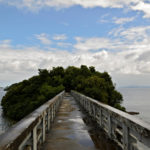
Dominican Republic
Dominican Republic
Dominican Republic
Dominican Republic – República Dominicana – is a Caribbean country, located on the eastern part of the island called Hispaniola in the Greater Antilles. The Dominican Republic occupies about 5/8 of island, the remaining 3/8 belongs to the state of Haiti. The borders between these states are about 360 kilometers long.
Geography
The Dominican Republic is located in the east part of the island of Hispaniola. Most of the territory of the Dominican Republic – about 40% are mountainous areas with forest stands. The highest mountain – Pico Duarte, is 3 087 m high, the lowest point is Lake Enriquillo, which lies below sea level. The lowlands stretch along the entire coastline. Average temperatures in the Dominican Republic range from 16 to 30°C. The annual total precipitation of the Dominican Republic ranges from 1,000 to 2,000 mm. The Dominican Republic is in the area which is often hit by hurricanes. However, the inhabitants knows about this fact so their buildings are more or less prepared for the hurricanes.
History
The island was discovered on December 6th, 1492 by Kryštof Kolumbus, and in 1496 the current capital of Santo Domingo was founded. Kolombus called the island as a “paradise on earth”. In the territory of today’s Dominican Republic, the first Spanish colony – a city, a university, a hospital in the “New World” was established. In 1697, Hispaniola was divided between France and Spain by signing a treaty from Rijswijk. In 1790, 40 000 white men, 25 000 free blacks and mulats and 60 000 slaves lived in the Spanish colony of Santo Domingo. In 1791–1803, a successful slaving rebellion took place in neighboring Haiti.
In 1981, the Spanish colony of Santo Domingo declared it’s independence. Shortly afterwards was occupied by the troops of the neighboring state of Haiti under whose rule the whole island was unified.
Resistance to the Haitian occupation grew and, after a successful armed uprising, the Dominican Republic in 1844 regained it’s the independence. The first president of the Dominican Republic was Pedro Santana, who remained in office until 1861. At the request of president Pedro Santana, the Dominican Republic became again for four years, the Spanish colony. This all for tactical reasons – the British have tried to gain control over the Dominican Republic. In 1865, the Dominican Republic gained his second independence from Spain.
In 1882, dictatorial leader Ulises Heureaux, who ruled until 1899, gets into power. Just like Haiti, the Dominican Republic has been occupied by the United States for several years, from 1916 to 1924. However, it was Dominican Republic who had a control over all taxes until 1940. In 1930, General Rafael Leonidas Trujillo Molina gets into power. Trujillo Molina was murdered on 30 May 1961 in the capital Santo Domingo.
In 1965, US troops supported by OAS troops were disembarked in the territory of the Dominican Republic. Until the new elections have been held (1966) number of thousands of casualties of local people were counted. The 1980s and 1990s – the time of global crisis and indebtedness was critical for the Dominican Republic. The International Monetary Fund has prepared a solution to help Dominican Republic and Local People to stabilize the situation, but it has received only more riots in response. This period was full of chaos and collapse. Another election was held, and Hipolito Meyu was elected. In 2002, a critical phase of the Dominican Republic was concluded with Balaguer’s death, and the Dominican Republic could begin to flourish again.
Population
Mulats make up 73% of the country’s population, 16% of whites, and 11% of blacks.
The life expectancy of men is aprox. 66 years, for women aprox. 69.4 years.
There are several hundred thousand immigrants from Haiti living in the country who usally perform less skilled jobs. Unfortunately they are still facing discrimination by the Dominicans. Interestingly, the decision of Dominican High Court in 2013 the said that children of Haitian immigrants born in the Dominican Republic are not entitled to have Dominican citizenship. This concerns up to 200,000 people.
Language
In the 11th century, the people of the Dominican Republic were forced to use the language of the most powerful tribe – the Taina tribe. In 1492, when the Dominican Republic was discovered by Kryštof Kolumbus, the Spanish language began to expand. The spread of Spanish culture was very cruel. Not to follow the new culture meant the death penalty for Dominicans. Dominican Spanish is characterized by the swallowing of words in the middle of words thanks to the indigenous accent.
The biggest cities
Santo Domingo – 2 800 000 inhabitants (capital)
Santiago de los Caballeros – 1 200 000 inhabitants
Puerto Plata – 313 000 inhabitants
San Pedro de Macorís – 220 000 inhabitants
La Romana – 210 000 inhabitants
Higuey – 163 000 inhabitants
Economy
More than 20% of the population of the Dominican Republic is working in agriculture. The main crop is sugar cane, bananas, cotton, cocoa, coffee, corn, manioc, peanuts, rice and tobacco. Poultry is the main meat source mostly because it is cheaper than beef or pork. Another meat sources are bovine, pig and goat. The most important economic sector is the mineral mining – asbestos, bauxite, chromium, copper, nickel, platinum, crude oil, silver, coal, uranium, gold and iron ore. An important economy branch is also the manufacturing industry. It includes sugar factories, rum distilleries and tobacco plants plantations, textile and clothing industry and petrochemicals.
The Dominican Republic is part of the Free Trade Zone between the US and several Central American countries – DR-CAFTA. According to World Bank data, Gross Domestic Product (GDP) per capita of the Dominican Republic has reached its PPP value in 2012 of 5 733 international dollars.
Tourism of the Dominican Republic
Tourism revenue is important component in the state budget of the Dominican Republic. Tourism revenue in 2009 amounted to almost 9.2% of total GDP. The Dominican Republic became a very popular destination in the 1990s, especially for discerning tourists from the West. Nearly 5 million tourists visit the Dominican Republic each year.


